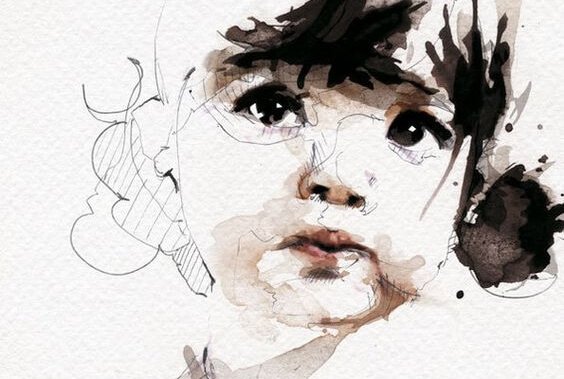The Electra Complex: What Is It and What Does It Do?


Written and verified by the psychologist Valeria Sabater
It was Carl Gustav Jung who explained one of the most well-know theories about girls’ psychosexual development: the Electra complex. The Swiss psychologist was inspired by the history and symbolism of the Greek myth of Electra.
Electra was the daughter of the king of Mycenae. She plotted a sophisticated plan along with her brother Orestes to avenge the death of their father. It involved killing her own mother and her mother’s lover.
It’s interesting to see the etymological meaning of the name. Electra means both “amber” and “spark” due to the static electricity that comes from amber, a fossil resin.
There were many modern authors who saw something complex and striking in the character and name. For example she inspired well-known novels such as Mourning Becomes Electra, by Eugene O’Neill. This book discussed the obscurities and psychological recesses inside a family of the 30’s.
“The pendulum of the mind alternates between meaning and nonsense, not between good and evil.”
– Carl Gustav Jung-
Jung’s theory
Carl Gustav Jung was the first to use this mythological figure from a psychological standpoint. In 1912, the concept of Electra would serve to illustrate girls’ early fixation on their parents.
The Electra complex is also the counterpart to the Oedipus complex, developed by Sigmund Freud. The Oedipus complex comes from the Oedipus myth of Sophocles, from classical Greek mythology. Here, the famous father of psychoanalysis held the idea that every boy goes through a stage of being attracted to his mother, perceiving his father as a rival.

Psychologists see this type of attraction (which may sound unusual to the average person) as a normal stage of psychological development for all children between 3 and 6 years old. After this age, this fixation or preference dissolves by itself naturally. Now let’s look at it in more detail…
How does the Electra complex start?
To understand this complex and how it forms, we have to get in the right context. We’re coming from a psychoanalysis approach. One aspect Sigmund Freud devoted much of his work to was psychosexual development and how sexuality is managed in the early stages of life. It was one of the great revolutions of Freudian thought. Until then, psychologists had not thought that children could have sexuality.
“To be a father, you have to stop being a son.”
-Carl Gustav Jung-
The way we develop our sexuality and respond to sexual impulses during early childhood will determine how fully we mature and how balanced and “healthy” our psycho-affective development is. However, maintaining certain fixations can lead to mental disorders. Freud himself labeled these neuroses and problems as “aberrant”.
But Carl Gustav Jung differed on these issues. Something that Jung perceived, in the first place, is that there was a serious “theoretical vacuum” in Freud’s theory. The Oedipus complex focused only on men, and only on the intense physical and emotional bond between sons and mothers in the first 6 years of life.
Therefore, he developed his theory of the Electra complex in 1912 to fill in that gap. His idea was to bring that perspective to the field of female development.
Characteristics of the Electra complex
The Electra complex involves different phases. Next we’ll explain very briefly what each phase is and how it manifests.
First stage: being attracted to the mother
Carl Jung was certain that the emotional bond between a girl and her mother is much more intense than between a boy and his mother in the first 3 years of life. This initial attachment will later mark “the return”. We’re talking about the need for the girl to identify with her mother to incorporate some of the maternal characteristics into her personality and even internalize her morality in the “super ego”.
Second stage: being attracted to the father

At 3 or 4 years old, the girl stops having such attraction to her mother and begins showing attraction towards her dad.
- The Electra complex starts, supposedly, when girls discover that they do not have a penis. So they now feel a desire to obtain what this sexual organ symbolizes. In addition, psychoanalysts affirm that this approach toward the paternal figure creates a certain rivalry and distance with respect to the mother.
- Girls may get jealous and display behaviors like possessive affection towards the father. Or she will display hostility if she doesn’t get what she wants from the father figure.
The natural resolution of the Electra complex
When the girl reaches 6 or 7 years old, she will again feel the need for closeness and identification with the mother. Thus, behaviors of imitation and curiosity towards the feminine world begin as she settles into her gender role.
Jung emphasized in his theory that this whole phase is part of a girl’s normal development. It makes up the basis of her emotional, social, and psychological behavior, which will continue to mature in later years. In the end, all friction should dissipate and girls shouldn’t see their mothers as enemies or rivals.
What is true about the Electra complex theory?

Many girls prefer their father at a certain time in their lives. However, we should note that modern psychology sees these Oedipal and Electra theories as very antiquated. They’re seen as out-of-date, like the classical psychosexual stages marked by an oral, anal, and phallic phase.
In fact, there are well-known psychoanalysts who do not share this vision and theory. For example, German psychoanalyst Karen Horney says that the idea that girls envy their fathers’ penis is offensive to women.
Now, if a girl displays behaviors as common as looking for dad’s affection more than mom’s, choosing to spend most of her time with him or saying she wants to “marry dad”, there is nothing bad or pathological about it.
After all, her father is her closest male role model. The fantasies, games, and behaviors will disappear naturally as socialization with peers becomes more important.
Actually, Carl Gustav Jung himself didn’t even give a completely biological or universal value to these behaviors. It is just a behavior that happens in some girls and usually resolves after a short time.
Bibliography:
-Freud, S. “Three Essays on the Theory of Sexuality” Basic Books: Nueva York
-Jayme, María y Victoria Sau (1996) Psicología diferencial del sexo y el género: fundamentos, pp. 109, 110. Icaria Editorial
-Jung, C. G.: Obras completas, Madrid: Editorial Trotta, 1999/2016.
-Scott, J. (2005). Electra después de Freud: El mito y la cultura. Estudios de Cornell en la historia de la psiquiatría. Ithaca: Cornell University Press.
It was Carl Gustav Jung who explained one of the most well-know theories about girls’ psychosexual development: the Electra complex. The Swiss psychologist was inspired by the history and symbolism of the Greek myth of Electra.
Electra was the daughter of the king of Mycenae. She plotted a sophisticated plan along with her brother Orestes to avenge the death of their father. It involved killing her own mother and her mother’s lover.
It’s interesting to see the etymological meaning of the name. Electra means both “amber” and “spark” due to the static electricity that comes from amber, a fossil resin.
There were many modern authors who saw something complex and striking in the character and name. For example she inspired well-known novels such as Mourning Becomes Electra, by Eugene O’Neill. This book discussed the obscurities and psychological recesses inside a family of the 30’s.
“The pendulum of the mind alternates between meaning and nonsense, not between good and evil.”
– Carl Gustav Jung-
Jung’s theory
Carl Gustav Jung was the first to use this mythological figure from a psychological standpoint. In 1912, the concept of Electra would serve to illustrate girls’ early fixation on their parents.
The Electra complex is also the counterpart to the Oedipus complex, developed by Sigmund Freud. The Oedipus complex comes from the Oedipus myth of Sophocles, from classical Greek mythology. Here, the famous father of psychoanalysis held the idea that every boy goes through a stage of being attracted to his mother, perceiving his father as a rival.

Psychologists see this type of attraction (which may sound unusual to the average person) as a normal stage of psychological development for all children between 3 and 6 years old. After this age, this fixation or preference dissolves by itself naturally. Now let’s look at it in more detail…
How does the Electra complex start?
To understand this complex and how it forms, we have to get in the right context. We’re coming from a psychoanalysis approach. One aspect Sigmund Freud devoted much of his work to was psychosexual development and how sexuality is managed in the early stages of life. It was one of the great revolutions of Freudian thought. Until then, psychologists had not thought that children could have sexuality.
“To be a father, you have to stop being a son.”
-Carl Gustav Jung-
The way we develop our sexuality and respond to sexual impulses during early childhood will determine how fully we mature and how balanced and “healthy” our psycho-affective development is. However, maintaining certain fixations can lead to mental disorders. Freud himself labeled these neuroses and problems as “aberrant”.
But Carl Gustav Jung differed on these issues. Something that Jung perceived, in the first place, is that there was a serious “theoretical vacuum” in Freud’s theory. The Oedipus complex focused only on men, and only on the intense physical and emotional bond between sons and mothers in the first 6 years of life.
Therefore, he developed his theory of the Electra complex in 1912 to fill in that gap. His idea was to bring that perspective to the field of female development.
Characteristics of the Electra complex
The Electra complex involves different phases. Next we’ll explain very briefly what each phase is and how it manifests.
First stage: being attracted to the mother
Carl Jung was certain that the emotional bond between a girl and her mother is much more intense than between a boy and his mother in the first 3 years of life. This initial attachment will later mark “the return”. We’re talking about the need for the girl to identify with her mother to incorporate some of the maternal characteristics into her personality and even internalize her morality in the “super ego”.
Second stage: being attracted to the father

At 3 or 4 years old, the girl stops having such attraction to her mother and begins showing attraction towards her dad.
- The Electra complex starts, supposedly, when girls discover that they do not have a penis. So they now feel a desire to obtain what this sexual organ symbolizes. In addition, psychoanalysts affirm that this approach toward the paternal figure creates a certain rivalry and distance with respect to the mother.
- Girls may get jealous and display behaviors like possessive affection towards the father. Or she will display hostility if she doesn’t get what she wants from the father figure.
The natural resolution of the Electra complex
When the girl reaches 6 or 7 years old, she will again feel the need for closeness and identification with the mother. Thus, behaviors of imitation and curiosity towards the feminine world begin as she settles into her gender role.
Jung emphasized in his theory that this whole phase is part of a girl’s normal development. It makes up the basis of her emotional, social, and psychological behavior, which will continue to mature in later years. In the end, all friction should dissipate and girls shouldn’t see their mothers as enemies or rivals.
What is true about the Electra complex theory?

Many girls prefer their father at a certain time in their lives. However, we should note that modern psychology sees these Oedipal and Electra theories as very antiquated. They’re seen as out-of-date, like the classical psychosexual stages marked by an oral, anal, and phallic phase.
In fact, there are well-known psychoanalysts who do not share this vision and theory. For example, German psychoanalyst Karen Horney says that the idea that girls envy their fathers’ penis is offensive to women.
Now, if a girl displays behaviors as common as looking for dad’s affection more than mom’s, choosing to spend most of her time with him or saying she wants to “marry dad”, there is nothing bad or pathological about it.
After all, her father is her closest male role model. The fantasies, games, and behaviors will disappear naturally as socialization with peers becomes more important.
Actually, Carl Gustav Jung himself didn’t even give a completely biological or universal value to these behaviors. It is just a behavior that happens in some girls and usually resolves after a short time.
Bibliography:
-Freud, S. “Three Essays on the Theory of Sexuality” Basic Books: Nueva York
-Jayme, María y Victoria Sau (1996) Psicología diferencial del sexo y el género: fundamentos, pp. 109, 110. Icaria Editorial
-Jung, C. G.: Obras completas, Madrid: Editorial Trotta, 1999/2016.
-Scott, J. (2005). Electra después de Freud: El mito y la cultura. Estudios de Cornell en la historia de la psiquiatría. Ithaca: Cornell University Press.
This text is provided for informational purposes only and does not replace consultation with a professional. If in doubt, consult your specialist.







